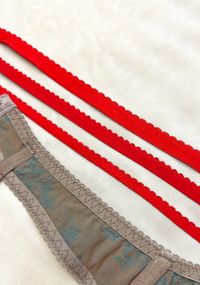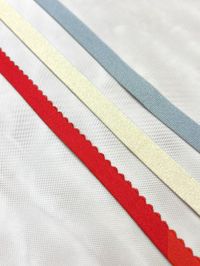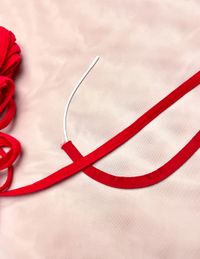Lingerie Elastics: Which One Goes Where? A Complete Guide to Types and Uses
If you’ve ever tried sewing lingerie, you know one thing for sure: elastics are essential. They don’t just hold the garment in place — they provide support, comfort, and durability. You can use the most luxurious lace or fabric, but without the right elastic, a bra or panties will never fit the way they should.
With so many types of lingerie elastics available, it’s easy to get confused. Which one is for the underband? Which for straps? Which only for decoration? Let’s break it down step by step and explore the most common elastics, their roles, and where exactly they belong.

Picot Elastic
The most recognizable elastic with tiny loops along the edge. It’s often used to finish panties and bra edges, but can also serve as underband elastic in bras.
It can come in different widths — from 8 mm up to 30 mm. The most popular ones are 10–15 mm.
Picot combines beauty and function: it looks delicate yet offers reliable support.
👉 Explore the picot elastics.

Underband Elastic
Wide, strong, and stable — underband elastic anchors the bra under the bust or supports the waist in lingerie pieces. It’s the backbone of comfort and fit.
It can come in different widths — from 8 mm up to 30 mm. The most popular ones are 10–15 mm.
✔️ Used in bras, garter belts, and corset-style garments.
✔️ The wider the elastic, the better the support.
👉 Browse lingerie elastics.

Fold Over Elastic (FOE)
FOE is designed to fold in half and enclose raw fabric edges. The result? A smooth, neat, and flexible finish without bulk.
It can come in different widths — from 10 mm up to 50 mm. The most popular ones are 15–20 mm.
✔️ Perfect for panties, bralettes, and lingerie trims.
✔️ Keeps thin fabrics flat and polished.
👉 Discover my elastics by colour or fold over elastics.

Panty Elastic
Soft, lightweight, and delicate — panty elastic is used to finish the leg openings and waistlines of panties. It provides a gentle hold without digging into the skin, making lingerie comfortable for everyday wear.
These elastics can be flat, scalloped, or slightly textured, and are available in a wide range of widths and colors.
They’re ideal for creating a smooth, flexible finish on any type of panties — from everyday styles to the most delicate lace designs.
👉 Browse lingerie elastics.

Bra Strap Elastic
Strong and supportive, yet comfortable enough for everyday wear. Strap elastic often has a shiny side and a matte reverse.
It can come in various widths — from 6 mm up to 25 mm. The most popular sizes are between 10 and 15 mm.
✔️ Used for bra straps, bralettes, and slips.
✔️ Can also be a design element — think decorative crossed straps on the back.
✔️ Available in different widths: narrow for delicate designs, wide for fuller support.
👉 Discover the elastics by colour or bra straps elastic.

Channeling Elastic (wire casing)
A plush, firm elastic designed to encase underwires. It secures them in place while protecting the skin from discomfort.
✔️ Essential for underwire bras.
✔️ Soft on the inside, sturdy on the outside.
Channeling tapes come in single-seam, double-seam, and seamless types, differing in their construction method and number of seams. They also vary by material (for example, plush or satin) and by stiffness (elastic or non-elastic).
👉 Discover the elastics by colour or channeling.

Decorative Elastic
When you want both function and beauty. With lace edges, metallic threads, or fancy patterns, decorative elastics elevate even the simplest lingerie design.
✔️ Perfect for bralettes, garter belts, suspenders, or accent details.
✔️ Adds a luxury, stylish finish.
👉 Browse lingerie elastics.

Silicone (Clear) Elastic
Almost invisible, yet incredibly useful. Clear elastic reinforces seams without changing the look of the garment.
✔️ Strengthens seams in stretch fabrics.
✔️ Commonly sewn into serged seams for lingerie sewing.
👉 Browse lingerie elastics.

H-Elastic
A narrow, flat elastic used to stabilize lace edges. Thanks to H-elastic, scalloped lace maintains its beautiful shape even after many washes.
It can come in different widths — from 5 mm up to 8 mm.
✔️ Frequently used in lace bras and panties.
✔️ Keeps scalloped edges neat and secure.
👉 Browse lingerie elastics.
Handy Tips for Choosing Lingerie Elastics
Final Thoughts
Elastics may seem like small details, but they are the foundation of well-made lingerie. They determine comfort, fit, and durability while also offering creative design opportunities. Mastering different types of elastics will help you create lingerie that looks stunning and feels amazing.
👉 Browse our complete collection of lingerie elastics.
✨ Match elastic to fabric. Lightweight mesh needs soft, delicate elastics, while dense microfiber or satin requires firmer ones.
✨ Think design. A decorative elastic can be the star of your lingerie — on straps, waistbands, or garter belts.
✨ Keep a variety. Narrow elastics are perfect for panties; wider ones give stability to bras and waistbands.
✨ Support matters. The larger the garment size, the wider the elastic should be — especially in bras — for reliable support and comfort.
✨ A little sewing trick. Stretch the elastic slightly while sewing, and it will sit evenly without rippling.
